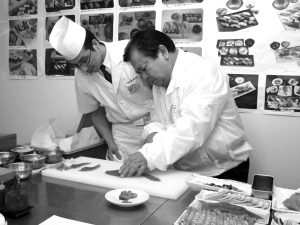
50 years ago when I entered the fishing industry, every year about 15 or so youths joined the large long-standing sushi restaurant that used to exist in Tsukiji. In order to become a sushi chef, these youths would undergo strict training that was said to include 3 years of preparing rice, 5 years of mixing the sushi rice, and a lifetime to master a piece of sushi. This was a time when 10 years was said to be needed to become proper sushi chef. Only a few would endure to the end to become sushi chefs, with most of them quitting before reaching their dreams.
Training would begin with washing dishes and deliveries, until they were allowed to accompany the sourcing outings to the market, and learn about the know-how of spotting quality seafood. From year 3 they could remove fish scales, during year 4 or 5 they could slice the fish into pieces for sushi, until finally during years 7 or 8 they were allowed to stand at the counter. I saw firsthand what went on behind the scenes and was concerned that such practice would ultimately result in fewer and fewer sushi chefs.
If there are no sushi chefs, sushi shops cannot exist. If this would continue, sushi as dietary culture, the pride of Japan would seize to exist. Such concerns became reality. During the golden age, there were around 50000 sushi restaurants nationwide, but by 2001, that number had fallen to under 15000. It was just after the economic crash when I launched SUSHIZANMAI to help the declining Tsukiji that I first became strongly aware of this problem. Sushi chefs are the backbone supporting the sushi culture. After SUSHIZANMAI Honten opened in April 2001, I insisted on having youth assist the chefs in preparing sushi. But reality was not kind. Due to their own experience, the sushi chefs usually ended up ordering around the younger members and used them like servants.
<<Shortening the training period from 10 to 2 years>>
They start working with hopes of becoming sushi chefs, but are not given an opportunity to prepare one even for years. This does not sound like the job of one’s dreams. That is why I looked for a new framework. My solution was the Kiyomura School, a school established for education of sushi chefs. They could focus on learning the fundamentals, and be able to work at a sushi counter after two years. Once they enter the school, they become employees and receive salary throughout the training course. All this with the purpose of enabling the students to attend to their studies with a peace of mind.
After enrollment, the basic curriculum would be comprised of morning classes on sanitation and nutrition, lectures on how to obtain a chef license and education on hospitality, to practical training in the afternoon. On the 2nd day of enrollment, students will be asked to cut fish and prepare tuna and squid sushi during practical training. I felt that it was important for students to experience the joy of preparing sushi as soon as possible, and then through consequent lectures learn the theory of what they are already aware of from practical experience.
The basic course is 3 months, followed by graduation exams. After passing, stationing at an actual shop for a year and 9 months to partake in practical training follows. Then, course completion verification exam and chef license exam need to be passed. Once completed, Class-4 Sushi Entertainer certification is granted, allowing the recipient to work the counter as a sushi chef. There are some chefs who have been able to proceed faster and receive the certification in as little as a year or 18 months. After that, the candidates are left to their own skills. I created a system for further professional development of sushi chefs through trade skill tests and promotion exams.
<<Create Happiness as a Sushi Entertainer. Creating Unconventional Courses>>
A sushi chef prepares the sushi while they converse with customers across the counter. Not only preparing sushi, but also entertaining customers through conversation while they enjoy the taste, and ensure they return home happy. That is the role I wish the students to embrace. That is why I also invite professional rakugo storytellers as lecturers to teach our students about conversation techniques, and how to entertain a crowd. Students will not learn only about the kind of story to tell, but also about the importance of pauses, rhythm and tempo of a conversation.
Additionally, I added an English course so that the visitors from foreign countries can enjoy as well. I want the students to not just learn techniques, but also to gain confidence and begin conversations. My wish is for my students to have the determination to become chefs, entertainers, as well as prophets of the sushi culture, which has become heritage of the world, the gist of Japanese pride.
(Interviewer: Masatoshi Ono)
Born in 1952, in the town of Sekiyado (present Noda City) in Chiba Prefecture. Graduated from Chuo University, Faculty of Law (Correspondence Course). After completion of middle school, joined the student platoon of the 4th Technical School of Japan Air Self-Defense Force. Retired from service in 1974. Joined a fishery company after working part-time jobs. Branched out on his own in 1979. In 2001, opened SUSHIZANMAI Honten (The Main Store), Japan’s first-ever sushi restaurant open 24 hours a day all year round, in the Tsukiji Outer Market.
